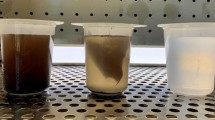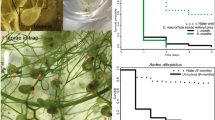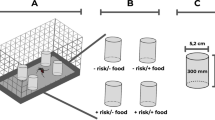Abstract
Oviposition habitat choices of species with aquatic larvae are expected to be influenced by both offspring risk of mortality due to predation, and offspring growth potential. Aquatic predators may indirectly influence growth potential for prey by reducing prey density and, for filter-feeding prey, by increasing bacterial food for prey via added organic matter (feces, partially eaten victims), creating the potential for interactive effects on oviposition choices. We tested the hypothesis that the mosquito Aedes aegypti preferentially oviposits in habitats with predatory Toxorhynchites larvae because of indirect effects of predation on chemical cues indicating bacterial abundance. We predicted that A. aegypti would avoid oviposition in sites with Toxorhynchites, but prefer to oviposit where bacterial food for larvae is abundant, and that predation by Toxorhynchites would increase bacterial abundances. Gravid A. aegypti were offered paired oviposition sites representing choices among: predator presence; the act of predation; conspecific density; dead conspecific larvae; and bacterial activity. A. aegypti preferentially oviposited in sites with Toxorhynchites theobaldi predation, and with killed conspecific larvae, but failed to detect preferences for other treatments. The antibiotic tetracycline eliminated the strongest oviposition preference. Both predation by Toxorhynchites and killed larvae increased bacterial abundances, suggesting that oviposition attraction is cued by bacteria. Our results show the potential for indirect effects, like trophic cascades, to influence oviposition choices and community composition in aquatic systems. Our results suggest that predators like Toxorhynchites may be doubly beneficial as biocontrol agents because of the attraction of ovipositing mosquitoes to bacterial by-products of Toxorhynchites feeding.



Similar content being viewed by others
References
Åbjörnsson L, Brönmark C, Hansson L (2002) The relative importance of lethal and non-lethal effects of fish on insect colonization of ponds. Freshwater Biol 47:1489–1495
Albeny-Simões D, Martins GF, Andrade MR, Krüger RF, Vilela EF (2011) Aedes aegypti survival in the presence of Toxorhynchites violaceus (Diptera: Culicidae) fourth instar larvae. Zoologia (Curitiba, Impresso) 28:538–540
Allan S, Kline D (1995) Evaluation of organic infusions and synthetic compounds mediating oviposition in Aedes albopictus and Aedes aegypti (Diptera: Culicidae). J Chem Ecol 21:1847–1860
Allan S, Kline D (1998) Larval rearing water and preexisting eggs influence oviposition by Aedes aegypti and Ae. albopictus (Diptera: Culicidae). J Med Entomol 35:943–947
Amador P (1995) Dispersal of Aedes aegypti in an urban area after blood feeding as demonstrated by rubidium-marked eggs. Am J Trop Med Hyg 52:177–179
Angelon KA, Petranka JW (2002) Chemicals of predatory mosquitofish Gambusia affinis influence selection of oviposition site by Culex mosquitoes. J Chem Ecol 28:797–806
Arav D, Blaustein L (2006) Effects of pool depth and risk of predation on oviposition habitat selection by temporary pool dipterans. J Med Entomol 43:493–497
Bentley MD, Day JF (1989) Chemical ecology and behavioral aspects of mosquito oviposition. Annu Rev Entomol 34:401–421
Binckley CA, Resetarits WJ Jr (2002) Reproductive decisions under threat of predation: squirrel treefrog Hyla squirella responses to banded sunfish Enneacanthus obesus. Oecologia 130:157–161
Binckley CA, Resetarits WJ Jr (2005) Habitat selection determines abundance, richness and species composition of beetles in aquatic communities. Biol Lett 1:370–374
Binckley CA, Resetarits WJ Jr (2008) Oviposition behavior partitions aquatic landscapes along nutrient and predation gradients. Behav Ecol 19:552–557
Blaustein L (1999) Oviposition site selection in response to risk of predation: evidence from aquatic habitats and consequences for population dynamics and community structure. Evolutionary theory processes: modern perspectives. Papers in Honour of Eviatar Nevo, pp 441–456
Blaustein L, Kiflawi M, Eitam A, Mangel M, Cohen J (2004) Oviposition habitat selection in response to risk of predation in temporary pools: mode of detection and consistency across experimental venue. Oecologia 138:300–305
Blaustein L, Blaustein J, Chase J (2005) Chemical detection of the predator Notonecta irrorata by ovipositing Culex mosquitoes. J Vector Ecol 30:299–301
Carpenter S, Kitchell J, Hodgson J (1985) Cascading trophic interactions and lake productivity. Bioscience 35:634–639
Chadee DD, Corbet PS, Greenwood JJD (1990) Egg-laying yellow fever mosquitoes avoid sites containing eggs laid by themselves or by conspecifics. Entomol Exp Appl 57:295–298
Chesson J (1984) Effect of notonectids (Hemiptera: Notonectidae) on mosquitoes (Diptera: Culicidae): predation or selective oviposition. Environ Entomol 13:531–538
Collins LE, Blackwell A (2000) The biology of Toxorhynchites mosquitoes and their potential as biocontrol agents. Biocontr News Inform 21:105–116
Colton YM, Chadee DD, Severson DW (2003) Natural skip oviposition of the mosquito Aedes aegypti indicated by codominant genetic markers. Med Vet Entomol 17:195–204
Crawley MJ (1993) GLIM for ecologists. Oxford
Edgerly JS, McFarland M, Morgan P, Livdahl T (1998) A seasonal shift in egg-laying behaviour in response to cues of future competition in a treehole mosquito. J Anim Ecol 67:805–818
Eitam A, Blaustein L, Mangel M (2002) Effects of Anisops sardea (Hemiptera: Notonectidae) on oviposition habitat selection by mosquitoes and other dipterans and on community structure in artificial pools. Hydrobiology 485:183–189
Ellis AM (2008) Incorporating density dependence into the oviposition preference–offspring performance hypothesis. J Anim Ecol 77:247–256
Fader JE, Juliano SA (2014) Oviposition habitat selection by container-dwelling mosquitoes: responses to cues of larval and detritus abundances in the field. Ecol Entomol (in press)
Fish D, Carpenter SR (1982) Leaf litter and larval mosquito dynamics in tree-hole ecosystems. Ecology 63:283–288
Hazard EI, Mayer MS, Savage KE (1967) Attraction and oviposition stimulation of gravid female mosquitoes by bacteria isolated from hay infusions. Mosq News 27:133–136
Honório NA, Silva WC, Leite PJ, Gonçalves JM, Lounibos LP, Lourenço-de Oliveira R (2003) Dispersal of Aedes aegypti and Aedes albopictus (Diptera: Culicidae) in an urban endemic dengue area in the state of Rio de Janeiro, Brazil. Mem Inst Oswaldo Cruz 98:191–198
Hurst TP, Kay BH, Brown MD, Ryan PA (2010) Melanotaenia duboulayi influence oviposition site selection by Culex annulirostris (Diptera: Culicidae) and Aedes notoscriptus (Diptera: Culicidae) but not Culex quinquefasciatus (Diptera: Culicidae). Environ Entomol 39:545–551
Juliano SA, Lounibos LP (2005) Ecology of invasive mosquitoes: effects on resident species and on human health. Ecol Lett 8:558–574
Juliano SA, Lounibos LP, Nishimura N, Greene K (2010) Your worst enemy could be your best friend: predator contributions to invasion resistance and persistence of natives. Oecologia 162:709–718
Kaufman MG, Bland SN, Worthen ME, Walker ED, Klug MJ (2001) Bacterial and fungal biomass responses to feeding by larval Aedes triseriatus (Diptera: Culicidae). J Med Entomol 38:711–719
Kaufman MG, Pelz-stelinski KS, Yee DA, Juliano SA, Ostrom PH, Walker ED (2010) Stable isotope analysis reveals detrital resource base sources of the tree hole mosquito, Aedes triseriatus. Ecol Entomol 35:586–593
Kershenbaum A, Spencer M, Blaustein L, Cohen JE (2012) Modelling evolutionarily stable strategies in oviposition site selection, with varying risks of predation and intraspecific competition. Evol Ecol 26:955–974
Kiesecker JM, Skelly DK (2000) Choice of oviposition site by gray treefrogs: the role of potential parasitic infection. Ecology 81:2939–2943
Kiflawi M, Blaustein L, Mangel M (2003) Predation-dependent oviposition habitat selection by the mosquito Culiseta longiareolata: a test of competing hypotheses. Ecol Lett 6:35–40
Kirchman DL (1993) Leucine incorporation as a measure of biomass production by heterotrophic bacteria. Handbook of methods in aquatic microbial ecology. Lewis 509–512
Kramer WL, Mulla MIRS (1979) Oviposition attractants and repellents of mosquitoes: oviposition responses of Culex mosquitoes to organic infusions. Environ Entomol 8:1111–1117
Kristan WB III (2003) The role of habitat selection behavior in population dynamics: source–sink systems and ecological traps. Oikos 103:457–468
Laurence B, Pickett J (1985) An oviposition attractant pheromone in Culex quinquefasciatus say (Diptera: Culicidae). Bull Entomol Res 75:283–290
Lima S, Dill L (1989) Behavioral decisions made under the risk of predation: a review and prospectus. Can J Zool 68:619–640
Lounibos P, Campos RE (2002) Investigaciones recientes sobre Toxorhynchites rutilus (Diptera Culicidae) con referencia al control biologico de mosquitos habitantes em recipientes. Entomotropica 17:146–156
Machado-Allison CE (1981) Ecologia de los mosquitos (Culicidae). II. Larvas y pupas. Acta Bio Venez 11:51–59
Magnhagen C (1991) Predation risk as a cost of reproduction. Trends Ecol Evol 6:183–186
Mayhew PJ (2001) Herbivore host choice and optimal bad motherhood. Trends Ecol Evol 16:165–167
McCall PJ (2002) Chemoecology of oviposition in insects of medical and veterinary importance. In: Hilker M, Meiners T (eds) Chemoecology of insect eggs and egg deposition. Blackwell, Berlin, pp 265–289
McCrae AW (1984) Oviposition by African malaria vector mosquitoes. II. Effects of site tone, water type and conspecific immatures on target selection by freshwater Anopheles gambiae giles, sensu lato. Ann Trop Med Parasitol 78:307–318
Merritt RW, Dadd RH, Walker ED (1992) Feeding behavior, natural food, and nutritional relationships of larval mosquitoes. Annu Rev Entomol 37:349–376
Miyagi I, Toma T, Mogi M (1992) Biological control of container-breeding mosquitoes, Aedes albopictus and Culex quinquefasciatus, in a Japanese island by release of Toxorhynchites splendens adults. Med Vet Entomol 6:290–300
Montserrat M, Bas C, Magalhaes S, Sabelis MW, de Roos AM, Janssen A (2007) Predators induce egg retention in prey. Oecologia 150:699–705
Moore JC, Berlow EL, Coleman DC, Ruiter PC, Dong Q, Hastings A, Johnson NC, McCann KS, Melville K, Morin PJ, Nadelhoffer K, Rosemond AD, Post DM, Sabo JL, Scow KM, Vanni MJ, Wall DH (2004) Detritus, trophic dynamics and biodiversity. Ecol Lett 7:584–600
Munga S, Minakawa N, Zhou G, Okeyo-Owuor JB, Githeko AK, Yan G (2006) Effects of larval competitors and predators on oviposition behavior of Anopheles gambiae s.s. J Med Entomol 43:221–224
Murrell EG, Juliano SA (2008) Detritus type alters the outcome of interspecific competition between Aedes aegypti and Aedes albopictus (Diptera: Culicidae). J Med Entomol 45:375
Murrell EG, Juliano SA (2013) Predation resistance does not trade off with competitive ability in early-colonizing mosquitoes. Oecologia 82:256–265
Murrell EG, Damal K, Lounibos LP, Juliano SA (2011) Distributions of competing container mosquitoes depend on detritus types, nutrient ratios, and food availability. An Entomol Soc Am 104:688–698
Navarro DMAF, de Oliveira PES, Potting RPJ, Brito AC, Fital SJF, Sant’Ana AEG (2003) The potential attractant or repellent effects of different water types on oviposition in Aedes aegypti L. (Dipt., Culicidae). J Appl Entomol 127:46–50
Nguyen TT, Su T, Mulla MS (1999) Bacteria and mosquito abundance in microcosms enriched with organic matter and treated with a Bacillus thuringiensis subsp. israelensis formulation. J Vector Ecol 24:191–201
Orizaola G, Brana F (2003) Do predator chemical cues affect oviposition site selection in newts? Herpetol J 13:189–193
Pamplona LDGC, Alencar CH, Lima JWO, Heukelbach J (2009) Reduced oviposition of Aedes aegypti gravid females in domestic containers with predatory fish. Trop Med Int Health 14:1347–1350
Petranka JW, Fakhoury K (1991) Evidence of a chemically-mediated avoidance response of ovipositing insects to blue-gills and green frog tadpoles. Copeia 1:234–239
Poelman EH, van Wijngaarden RPA, Raaijmakers CE (2013) Amazon poison frogs (Ranitomeya amazonica) use different phytotelm characteristics to determine their suitability for egg and tadpole deposition. Evol Ecol 27:661–674
Ponnusamy L, Xu N, Nojima S, Wesson DM, Schal C, Apperson CS (2008a) Identification of bacteria and bacteria-associated chemical cues that mediate oviposition site preferences by Aedes aegypti. Proc Natl Acad Sci USA 105:9262–9267
Ponnusamy L, Xu N, Stav G, Wesson DM, Schal C, Apperson CS (2008b) Diversity of bacterial communities in container habitats of mosquitoes. Microb Ecol 56:593–603
Ponnusamy L, Wesson DM, Arellano C, Schal C, Apperson CS (2010) Species composition of bacterial communities influences attraction of mosquitoes to experimental plant infusions. Microb Ecol 59:158–173
R Development Core Team (2011) R: a language and environment for statistical computing. R Foundation for statistical computing, Vienna, Austria. ISBN 3-900051-07-0. http://www.R-project.org/
Reiskind MH, Wilson ML (2004) Culex restuans (Diptera: Culicidae) oviposition behavior determined by larval habitat quality and quantity in southeastern Michigan. J Med Entomol 41:179–186
Reiter P (2007) Oviposition, dispersal, and survival in Aedes aegypti: implications for the efficacy of control strategies. Vec-Borne Zoonot Dis 7:261–273
Rejmankova E, Roberts DA, Manguin S, Pope KO, Komarek J, Post RA (1996) Anopheles albimanus (Diptera: Culicidae) and cyanobacteria: an example of larval habitat selection. Environ Entomol 25:1058–1067
Resetarits WJ Jr (1996) Oviposition site choice and life history evolution. Am Zool 36:205–215
Resetarits WJ Jr (2001) Colonization under threat of predation: avoidance of fish by an aquatic beetle, Tropisternus lateralis (Coleoptera: Hydrophilidae). Oecologia 129:155–160
Resetarits WJ Jr, Wilbur HM (1989) Choice of oviposition site by Hyla chrysoscelis: role of predators and competitors. Ecology 70:220–228
Rieger JF, Binckley CA, Resetarits WJ Jr (2004) Larval performance and oviposition site preference along a predation gradient. Ecology 85:2094–2099
Roitberg BD, Mondor EB, Tyerman AGJ (2003) Pouncing spider, flying mosquito: blood acquisition increases predation risk in mosquitoes. Behav Ecol 5:736–740
Rubio Y, Rodriguez D, Machado-Allison CE, Lon JA (1980) Algunos aspectos de lo comportamiento de Toxorhynchites theobaldi (diptera: Culicidae). Acta Cien Venez 31:345–351
Sant’ana AL, Roque RA, Eiras AE (2006) Characteristics of grass infusions as oviposition attractants to Aedes (Stegomyia) (Diptera: Culicidae). J Med Entomol 43:214–220
Santos E, Correia J, Muniz L, Meiado M, Albuquerque C (2010) Oviposition activity of Aedes aegypti L. (Diptera: Culicidae) in response to different organic infusions. Neotrop Entomol 39:299–302
Schreiber ET (2007) Toxorhynchites. J Am Mosq Contr Assoc 23:129–132
Silberbush A, Blaustein L (2008) Scientific note: oviposition habitat selection by a mosquito in response to a predator: are predator-released kairomones air-borne cues? J Vector Ecol 33:208–211
Silberbush A, Markman S, Lewinsohn E, Bar E, Cohen JE, Blaustein L (2010) Predator-released hydrocarbons repel oviposition by a mosquito. Ecol Lett 13:1–10
Stav G, Blaustein L, Margalit Y (2000) Influence of nymphal Anax imperator (Odonata: Aeshnidae) on oviposition by the mosquito Culiseta longiareolata (diptera: Culicidae) and community structure in temporary pools. J Vector Ecol 25:190–202
Steffan WA, Evenhuis NL (1981) Biology of toxorhynchites. Annu Rev Entomol 26:159–181
Styer LM, Minnick SL, Sun AK, Scott TW (2007) Mortality and reproductive dynamics of Aedes aegypti (Diptera: Culicidae) fed human blood. Vector-Borne Zoonot Dis 7:86–98
Suleman M, Shirin M (1981) Laboratory studies on oviposition behaviour of Culex quinquefasciatus say (Diptera: Culicidae): choice of oviposition medium and oviposition cycle. Bull Entomol Res 71:361–369
Sumba LA, Ogbunugafor CB, Deng AL, Hassanali A (2008) Regulation of oviposition in Anopheles gambiae s.s.: role of inter- and intra-specific signals. J Chem Ecol 34:1430–1436
Tabachnick WJ, Powell JR (1979) A world-wide survey of genetic variation in the yellow fever mosquito, Aedes aegypti. Genet Res 34:215–229
Torres-Estrada JL, Rodriguez MH, Cruz-Lopez L, Arredondo-Jimenez JI (2001) Selective oviposition by Aedes aegypti (Diptera: Culicidae) in response to Mesocyclops longisetus (Copepoda: Cyclopoidea) under laboratory and field conditions. J Med Entomol 38:188–192
Trexler JD, Apperson CS, Zurek L, Gemeno C, Schal C, Kaufman M, Walker E, Watson DW, Wallace L (2003) Role of bacteria in mediating the oviposition responses of Aedes albopictus (Diptera: Culicidae). J Med Entomol 40:841–848
Verma B, Robarts RD, Headley J (2007) Effect of tetracycline on the colonization and growth of microbes on Scirpus lacustris litter in oligotrophic and eutrophic waters. Aquat Microb Ecol 47:91–98
Vonesh J, Blaustein L (2010) Predator-induced shifts in mosquito oviposition site selection: a meta-analysis and implications for vector control. Isr J Ecol Evol 56:263–279
Vonesh JR, Kraus JM, Rosenberg JS, Chase JM (2009) Predator effects on aquatic community assembly: disentangling the roles of habitat selection and post-colonization processes. Oikos 118:1219–1229
Walker ED, Lawson DL, Merritt RW, Morgan WT, Klug MJ (1991) Nutrient dynamics, bacterial populations, and mosquito productivity in tree hole ecosystems and microcosms. Ecology 72:1529–1546
Wellborn GA, Skelly DK, Werner EE (1996) Mechanisms creating community structure across a freshwater habitat gradient. Annu Rev Ecol Syst 27:337–363
Werner EE, Gilliam JF (1984) The ontogenetic niche and species interactions in size-structured populations. Annu Rev Ecol Syst 15:393–425
Wilmot TR, Cope SE, Ban AR (1987) The effect of immature mosquitoes on oviposition by Culex pipiens quinquefasciatus and Culiseta incidens (Diptera: Culicidae) in the field. Bull Soc Vector Ecol 12:512–516
Wisenden BD (2000) Olfactory assessment of predation risk in the aquatic environment. Philos Trans R Soc B: Biol Sci 355:1205–1208
Wong J, Stoddard ST, Astete H, Morrison AC, Scott TW (2011) Oviposition site selection by the dengue vector Aedes aegypti and its implications for dengue control. PLoS Neglect Trop Dis 5:1–12
Wong J, Morrison AC, Stoddard ST, Astete H, Chu YY, Baseer I, Scott TW (2012) Linking oviposition site choice to offspring fitness in Aedes aegypti: consequences for targeted larval control of dengue vectors. PLoS Neglect Trop Dis 6:1–12
Yee DA, Juliano SA (2006) Consequences of detritus type in an aquatic microsystem: effects on water quality, micro-organisms and performance of the dominant consumer. Freshwater Biol 51:448–459
Yee DA, Kaufman MG, Juliano SA (2007a) The significance of ratios of detritus types and micro-organism productivity to competitive interactions between aquatic insect detritivores. J Anim Ecol 76:1105–1115
Yee DA, Kesavaraju B, Juliano SA (2007b) Direct and indirect effects of animal detritus on growth, survival, and mass of invasive container mosquito Aedes albopictus (Diptera: Culicidae). J Med Entomol 44:580–588
Yoshioka M, Couret J, Kim F, McMillan J, Burkot TR, Dotson EM, Kitron U, Vazquez-Prokopec GM (2012) Diet and density dependent competition affect larval performance and oviposition site selection in the mosquito species Aedes albopictus (Diptera: Culicidae). Parasites Vectors 5:225
Zahiri N, Raul ME (1998) Oviposition attraction and repellency of Aedes aegypti (Diptera: Culicidae) to waters from conspecific larvae subjected to crowding, confinement, starvation, or infection. J Med Entomol 35:782–787
Zar JH (1999) Biostatistical analysis, 4th edn. Prentice Hall, Upper Saddle River
Zuharah WF, Lester PJ (2010) Can adults of the New Zealand mosquito Culex pervigilans (Bergorth) detect the presence of a key predator in larval habitats? J Vector Ecol 35:100–105
Acknowledgments
We thank Rubens Junior for aid in the laboratory. We thank Drs. Gustavo Ferreira Martins, Nildimar Honório, and Ricardo Idelfonso Campos for useful discussion, and two anonymous referees for comments on the manuscript. We are especially grateful to both the Entomology Graduate Program, Entomology Department, Federal University of Viçosa, Brazil and the School of Biological Sciences, Illinois State University, USA, A fellowship from CNPq Brazil supported D. A. S.’s visit to S. A. J.’s laboratory. Additional funding was from NIAID grant R15 AI075306-01 to S. A. J.
Author information
Authors and Affiliations
Corresponding author
Additional information
Communicated by Andreas Prinzing.
Rights and permissions
About this article
Cite this article
Albeny-Simões, D., Murrell, E.G., Elliot, S.L. et al. Attracted to the enemy: Aedes aegypti prefers oviposition sites with predator-killed conspecifics. Oecologia 175, 481–492 (2014). https://doi.org/10.1007/s00442-014-2910-1
Received:
Accepted:
Published:
Issue Date:
DOI: https://doi.org/10.1007/s00442-014-2910-1




